Mensuration Exercise – 10.1
Question 1. Find the perimeter of each of the following figures:

Solution:
- Perimeter = Sum of all the sides = 4 cm + 2 cm +1 cm + 5 cm = 12 cm
- Perimeter = Sum of all the sides = 23 cm + 35 cm + 40 cm + 35 cm = 133 cm
- Perimeter = Sum of all the sides = 15 cm + 15 cm + 15 cm + 15 cm = 60 cm
- Perimeter = Sum of all the sides =4 cm+4 cm+4 cm+4 cm+ 4 cm=20 cm
- Perimeter = Sum of all the sides =1 cm + 4 cm + 0.5 cm + 2.5 cm + 2.5 cm + 0.5 cm + 4 cm = 15 cm
- Perimeter = Sum of all the sides = 4cm +lcm + 3cm + 2cm + 3cm + 4cm +lcm + 3cm + 2cm + 3cm + 4cm + lcm + 3cm + 2cm + 3cm + 4cm +lcm + 3cm + 2cm + 3cm = 52 cm
Question 2. The lid of a rectangular box of sides 40 cm by 10 cm is sealed all round with tape. What is the length of the tape required?
Solution:
Total length of tape required
= Perimeter of rectangle
= 2 (length + breadth)
= 2(40 +10) cm = 2 x 50 cm = 100 cm =1 m
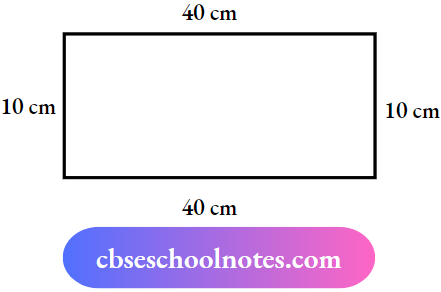
Thus, the total length of tape required is 100 cm or 1 m.
Question 3. A table-top measures 2 m 25 cm by 1 m 50 cm. What is the perimeter of the tabletop?
Solution:
Length of table-top = 2m 25 cm = 2.25 m
Breadth of table-top =1 m 50 cm = 1.50 m
Perimeter of table-top = 2 x (length + breadth)
= 2 x (2.25 + 1.50) m
= 2 x 3.75 m = 7.50 m
Thus, the perimeter of the table-top is 7.5 m
Question 4. What Is the length of the wooden strip required to frame a photograph of length and breadth of 32 cm and 21 cm respectively?
Solution:
Length of the wooden strip
= Perimeter of photograph
= 2 x (length + breadth)
= 2 (32 + 21) cm = 2 x 53 cm = 106 cm
Thus, the length of the wooden strip required is 106 cm
Question 5. A rectangular piece of land measures 0.7 km by 0.5 km. Each side is to be fenced with 4 rows of wires. What is the length of the wire needed?
Solution:
Since 4 rows of wires are needed.
Therefore, the total length of the wire is equal to 4 times the perimeter of land.
Perimeter of land = 2 x (length + breadth)
= 2 x (0.7 + 0.5) km = 2 x 1.2 km = 2.4 km
= 2.4 x 1000 m = 2400 m
Thus, the length of wire = 4 x 2400 m = 9600 m = 9.6 km
Question 6. Find the perimeter of each of the following shapes :
- A triangle of sides 3 cm, 4 cm and 5 cm.
- An equilateral triangle of side 9 cm.
- An isosceles triangle with equal sides 8 cm each and third side 6 cm.
Solution:
1. Perimeter of ΔABC
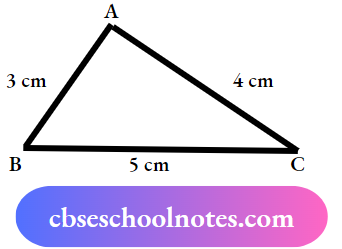
=AB+BC+CA
= 3cm+5cm+4cm
= 12 cm
2. Perimeter of equilateral
ΔABC
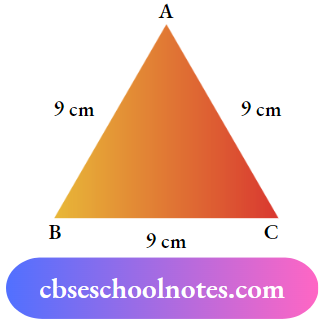
= 3 x side
= 3 x 9 cm
= 27 cm
3. Perimeter of ΔABC
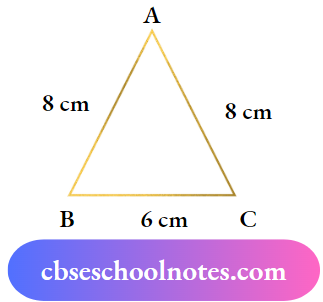
= AB + BC + CA
= 8cm + 6cm + 8cm
= 22 cm

Question 7. Find the perimeter of a triangle with sides measuring 1 0 cm, 1 4 cm and 1 5 cm.
Solution:
Perimeter of triangle = Sum of all three sides
= 10 cm + 14 cm + 15 cm = 39 cm
Thus, the perimeter of the triangle is 39 cm.
Question 8. Find the perimeter of a regular hexagon with each side measuring 8 m.
Solution:
The perimeter of a regular hexagon
= 6 x length of one side
= 6 x 8m = 48m
Thus, the perimeter of a regular hexagon is 48 m.
Question 9. Find the side of the square whose perimeter is 20 m,
Solution:
The perimeter of the square = 4 x side
20 m = 4 x side ⇒ side = \(=\frac{20}{4} \mathrm{~m}=5 \mathrm{~m}\)
Thus, the side of the square is 5 m.
Question 10. The perimeter of a regular pentagon is 1 00 cm. How long is it on each side?
Solution:
The perimeter of a regular pentagon = 5 x side
100 cm = 5 x side ⇒ side = \(\frac{100}{5} \mathrm{~cm}=20 \mathrm{~cm}\)
Thus, the side of the regular pentagon is 20 cm.
Question 11. A piece of string is 30 cm long. What will be the length of each side if the string is used to form:
- A square?
- An equilateral triangle?
- A regular hexagon?
Solution:
Length of string= Perimeter of each shape
The perimeter of the square = 4 x side
30 cm = 4 x side ⇒ side = \(\frac{30}{4} \mathrm{~cm}=7.5 \mathrm{~cm}\)
Thus, the length of each side of the square will be 7.5 cm
The perimeter of equilateral triangle = 3 x side
30 cm = 3 x side ⇒ side =\(\frac{30}{3} \mathrm{~cm}=10 \mathrm{~cm}\)
Thus, each side of the equilateral triangle will be 10 cm long.
The perimeter of a regular hexagon = 6 x side
30 cm = 6 x side ⇒ side = \(\frac{30}{6} \mathrm{~cm}=5 \mathrm{~cm}\)
Thus, each side of a regular hexagon will be 5 cm long.
Question 12. Two sides of a triangle are 12 cm and 14 cm. The perimeter of the triangle is 36 cm. What is its third side?
Solution:
Let the length of the third title be x cm. The length of the other two sides are 12 cm and 14 cm
Now, the perimeter of the triangle = 36 cm
12 + 14 + x = 36
26 + x = 36
X = 36- 26 ⇒ x = 10
Thus, the length of the third side is 10 cm
Question 13. Find the cost of fencing a square park of side 250 m at the rat of? 20 per metre.
Solution:
Side of square park = 250 m
The perimeter of the square park = 4 x side
= 4 x 250 m = 1000 m
Sin ce, cost of fencing for metre = ₹ 20
Therefore, the cost of fencing for 1000 metres
= ₹ 20×1000 = ₹ 20,000
Question 14. Find the cost of fencing a rectangular park of length 175 m and breadth 125 m at the rate of ₹ 12 per metre
Solution:
Length of rectangular park = 175 m
The breadth of the rectangular park = 125 m
Perimeter of park = 2 x (length + breadth)
= 2 x (175 + 125) m
= 2 x 300 m = 600 m
Since, the cost of fencing a park for metre = ? 12
Therefore, the cost of fencing the park for 600 m
= ₹ 12 x 600 = ₹ 7,200
Question 15. Sweety runs around a square park of side 75 m. Bulbul runs around a rectangular park with a leaf of 60 m a and breadth of h 45 m. Who covers less distance?
Solution:
Distance covered by Sweety
= Perimeter of square park = 4 x side
= 4 x 75 m = 300 m
Thus, the distance covered by Sweety is 300 m.
Nthe ow, distance covered by Bulbul
= Perimeter of a rectangular park
= 2 x (length + breadth)
= 2 x (60 + 45) m
= 2 x 105 m = 210 m
Thus, Bulbul covers a distance of 210 m.
So, Bulbul covers less distance.
Question 16. What is the perimeter of each of the following figures? What do you infer from the answers?
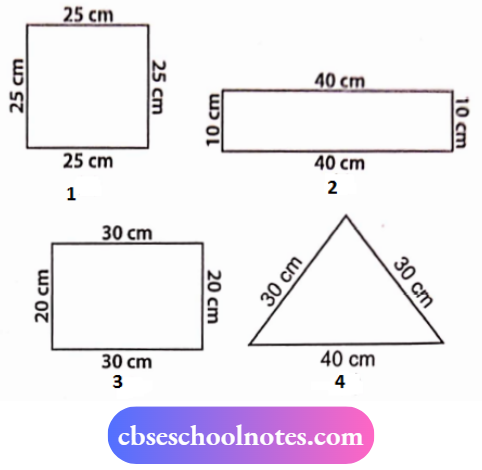
Solution:
Perimeter of square = 4 x side = 4 x 25 cm = 100 cm
Perimeter of rectangle = 2 x (length + breadth)
= 2 x (40 + 10) cm = 2 x 50 cm = 100 cm
Perimeter of rectangle = 2 x (length + breadth)
= 2 x (30 + 20) cm = 2 x 50 cm = 100 cm
Perimeter of triangle = Sum of all sides
= 30 cm + 30 cm + 40 cm
= 100 cm
Thus, all the figures have the same perimeter
Question 17. Avneet buys 9 square paving slabs, each with a side of \(\frac{1}{2}\) m. He lays them in the form of a square.
- What is the perimeter of his arrangement?
- Shari does not like his arrangement. She gets him to lay them out like a cross. What is the perimeter of her arrangement? ent.
- Which a has greater perimeter?
- Avneet wonders if there is a way of getting an even greater perimeter. Can you find a way of doing this? (The paving slabs must meet along complete edges i.e. they cannot be broken.)
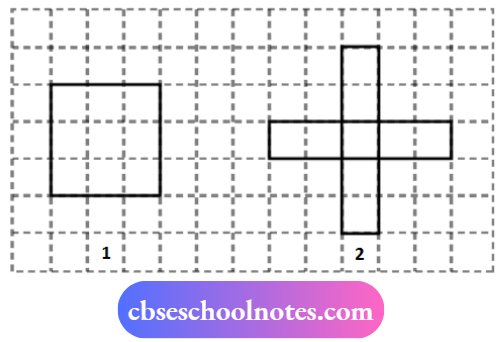
Solution:
1. Side of one small square = \(\frac{1}{2}\) m
Side of given square ⇒ \(\frac{3}{2}\) perimetereter of square = 4 x side
⇒\(4 \times \frac{3}{2} \mathrm{~m}=6 \mathrm{~m}\)
2. The perimeter of the given figure
⇒ Sum of all sides = \(20 \times \frac{1}{2} \mathrm{~m}=10 \mathrm{~m}\)
3. The arrangement crosses a greater perimeter.
4. It is not possible to determine the arrangement with a perimeter greater than 10 m.
Mensuration Exercise – 10.2
Question 1. Find the areas of the following figures by countsquaresuare:
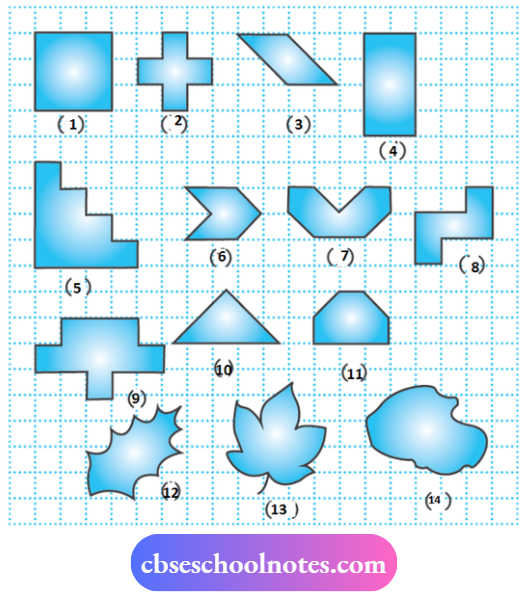
Solution:
1. Number of filled squares = 9
∴ Area covered by filled squares
= (9 x 1) sq units = 9 sq units
2. Number of filled squares = 5
∴ Area covered by filled squares
= (5 x 1) sq units = 5 sq units
3. Number of fully-filled squares = 2
Number of half-filled squares = 4
∴ Area covered by fully-filled squares
= (2 x 1) sq units = 2 sq units
Area covered by half-filled squares
⇒ \(\left(4 \times \frac{1}{2}\right) \text { sq units }=2 \text { sq units }\)
Total area = (2 + 2) sq units = 4 sq units
4. Number of filled squares = 8
∴ Area covered filled squares
= (8 x 1) sq units = 8 sq units
5. Number of filled squares = 10
∴ Area covered by filled squares
= (10 x 1) sq units = 10 sq units
6. Number of fully-filled squares = 2
Number of half-filled squares = 4
∴ Area covered by fully-filled squares
= (2 x 1) sq units = 2 sq units
Area covered by half-filled squares
⇒ \(\left(4 \times \frac{1}{2}\right) \text { sq units }=2 \text { sq units }\)
Total area = (2 + 2) sq units = 4 sq units
7. Number of fully-filled squares = 4
Number of half-filled squares = 4
∴ Area covered by fully-filled squares
= (4 x 1) sq units = 4 sq units
Area covered by half-filled squares
⇒ \(\left(4 \times \frac{1}{2}\right) \text { sq units }=2 \text { sq units }\)
∴ Total area = (4 + 2) sq units = 6 sq units
8. Number of filled squares = 5
∴ Area covered by filled squares
= (5 x 1) sq units = 5 sq units
9. Number of filled squares = 9
∴ Area covered by filled squares
= (9 x 1) sq units = 9 sq units
10. Number of fully-filled squares = 2
Number of half-filled squares = 4
∴ Area covered by fully-filled squares
= (2 x 1) sq units = 2 sq units
Area covered by half-filled squares
⇒ \(\left(4 \times \frac{1}{2}\right) \text { sq units }=2 \text { sq units }\)
∴ Total area = (2 + 2) sq units = 4 sq units
11. Number of fully-filled squares = 4
Number of half-filled squares = 2
∴ Area covered by fully-filled squares
= (4 x 1) sq units = 4 sq units
Area covered by half-filled squares
⇒ \(\left(2 \times \frac{1}{2}\right) \text { sq units }=1 \text { sq units }\)
Total area = (4+1) sq units = 5 sq units
12. Number of fully-filled squares = 3,
Number of half-filled squares* 2,
Number of more than half-filled
squares = 4
and number of less than half-filled squares = 4.
Now, estimated area covered by fully-filled squares = 3 sq units, half-filled squares = \(\left(2 \times \frac{1}{2}\right) \text { sq units }\)
=1 sq unit
more than half-filled squares = 4 sq units and less than half-filled squares = 0 sq unit
∴ Total area- (3 +1 + 4 + 0) sq units = 8 sq units
13. Number of fully-filled squares = 7,
Number of more than half-filled
squares = 7
The number of less than half-filled
squares = 5
Estimated area covered by
fully-filled squares = 7 sq units,
more than half-filled squares = 7 sq units
and less than half-filled squares = 0 sq unit
∴ Total area = (7 + 7 + 0) sq units = 14 sq units
14. Number of fully-filled squares = 10,
Number of more than half-filled squares = 8
and number of less than half-filled squares = 5
Estimated area covered by
fully-filled squares = 10 sq units,
more than half-filled squares = 8 sq units
less than half-filled squares = 0 squint
∴ Total area= (10 + 8 + 0) sq units = 18 sq units
Mensuration Exercise – 10.3
Question 1. Find the areas of the rectangles whose sides are:
- 3 cm and 4 cm
- 12 m and 21 m
- 2 km and 3 km
- 2 m and 70 cm
Solution:
- Area of rectangle = length x breadth = 3 cm x 4 cm = 12 cm²
- Area of rectangle- length x breadth = 12 m x 21 m = 252 m²
- Area of rectangle = length x breadth = 2 km x 3km = 6 km²
- Area of rectangle = length x breadth = 2 m x 70 cm = 2 m x 0.7 m = 1.4 m²
Question 2. Find the areas of the squares whose sides are:
- 10 cm
- 14 cm
- 5 m
Solution:
- Area of square = side x side = 10 cm x 10 cm = 100 cm²
- Area of square = side x side = 14 cm x 14 cm = 196 cm²
- Area of square = side x side =5mx5m = 25m²
Question 3. The length and breadth of the three rectangles are as given below:
- 9 m and 6 m
- 17 m and 3 m
- 4 m and 14 m
Which one has the largest area and which one has the smallest?
Solution:
- Area of rectangle = length x breadth =9mx6m= 54m²
- Area of rectangle = length x breadth = 17m x 3 m = 51 m²
- Area of rectangle = length x breadth = 4 m x 14 m = 56 m²
Thus, rectangle (c) has the largest area, therefore 56 m2 and rectangle (b) has the smallest area, therefore, 51 m²
Question 4. The area of a rectangular garden 50 m long is 300 sq m. Find the width of the garden.
Solution:
Length of rectangle = 50 m
Area of rectangle = 300 m²
Since, area other rectangle = length x breadth
Therefore, breadth \(=\frac{\text { area of rectangle }}{\text { length }}\)
⇒ \(=\frac{300}{50} \mathrm{~m}=6 \mathrm{~m}\)
Thus, the breadth of the garden is 6 m
Question 5. What is the cost of tiling a rectangular plot of land 500 m long and 200 m wide at the rate of ₹ 8 per hundred sq m?
Solution:
Length of land = 500 m
Breadth of land = 200 m
Area of land = length x breadth = 500 m x 200 m = 1,00,000 sqm
Cost of tiling 100 sq m of land = ₹ 8
Cost of tiling 1,00,000 sq m of land
⇒ \(₹ \frac{8 \times 100000}{100}=₹ 8000\)
Question 6. A table-top measures 2 m by 1 m 50 cm. What is its area in square metres?
Solution:
Length of table-top = 2 m
Breadth of table-top =1 m 50 cm = 1.50m
Area of table-top = length x breadth = 2 m x 1.50 m = 3 m²
Question 7. A room is 4 m long and 3 m 50 cm wide. How many square metres of carpet is needed to cover the floor of the room?
Solution:
Length of room = 4 m
And breadth of room = 3 m 50 cm = 3.50 m
Area of carpet = length x breadth = 4 m x 3.50 m = 14 m²
Question 8. A floor is 5 m long and 4 m wide. A square carpet of sides 3 m is laid on the floor. Find the area of the floor that is not carpeted.
Solution:
Length of floor = 5 m
The d breadth of the floor = 4 m
Area of floor = length x breadth = 5mx4m = 20m²
Now, side the f square carpet = 3 m
Area of square carpet = side x side = 3mx3m = 9m²
Area of floor that is not carpeted = 20 m²- 9 m² = 11 m²
Question 9. Five square flower beds each of sides 1 m are dug on a piece of land 5 m long and 4 m wide. What is the area of the remaining part of the land?
Solution:
Side of square flower bed =1 m
Area of square flower bed = side x side =lm x lm = lm²
Area of 5 square flower beds = (1×5) m²
= 5 m²
Now, length of land = 5 m
The d breadth of land = 4 m
Area of land = length x breadth – 5 m x 4 m
=20 m²
Area of remaining part
= Area of land- Area of 5 flower beds
= 20 m²- 5 m² = 15 m²
Question 10. By splitting the following figures into rectangles, find their areas (The measures are given in centimetres).
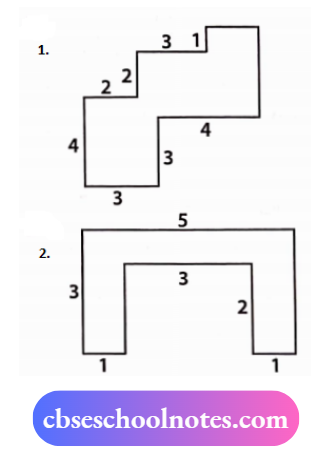
Solution:
1. we have,

Area of square HKLM = 3×3 cm²= 9 cm²
Area of rectangle IJGH-1×2 cm² = 2 cm²
Area of square FEDG = 3×3 cm² = 9 cm²
Area of rectangle ABCD = 2×4 cm² = 8 cm²
Total area of the figure = (9 + 2 + 9 + 8) cm² = 28 cm²
2. we have,

Area of rectangle ABCD =3×1 cm² = 3 cm²
Area of rectangle BJEF = 3×1 cm² = 3 cm²
Area of rectangle FGHI = 3×1 cm² = 3 cm²
Total area of the figure = (3 + 3 + 3) cm² = 9 cm²
Question 11. Split the following shapes into rectangles and find their areas. (The measures are given in centimetres).

Solution:
1. We have,

Area of rectangle ABCD = 2 x 10 cm² = 20 cm²
Area of rectangle DEFG = 10 x 2 cm² = 20 cm²
Total area of the figure = (20 + 20) cm²
= 40 cm²
2. We have,

There are 5 squares each of side 7 cm.
Area of one square = 7×7 cm² = 49 cm²
Area of 5 squares = 5 x 49 cm² = 245 cm²
3. We have,
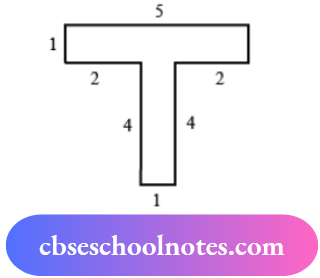
Area of rectangle ABCD = 5 x 1 = 5 cm²
Area of rectangle EFGH = 4 x 1 = 4 cm²
Total area of the figure = (5+4) cm²
= 9 cm²
Question 12. How many tiles whose length and breadth are 12 cm and 5 cm respectively will be needed to fit in a rectangular region whose length and breadth are respectively:
- 100 cm and 144 cm
- 70 cm and 36 cm.
Solution:
1. The area of the rectangular region
=length x breadth= 100 cm x 144 cm= 14400 cm²
Area of one tile = 12 cm x 5 cm = 60 cm²
Number of tiles = \(=\frac{\begin{array}{r}
\text { Area of rectangular region }
\end{array}}{\text { Area of one tile }}\)
Thus, 240 tiles are required.
2. The area of the rectangular region
= length x breadth = 70 cm x 36 cm = 2520 cm²
Area of one tile = 12 cm x 5 cm- 60 cm²
Number of tiles \(=\frac{\text { Area of rectangular region }}{\text { Area of one tile }}=\frac{2520}{60}=42\)
Thus, 42 tiles are required.
